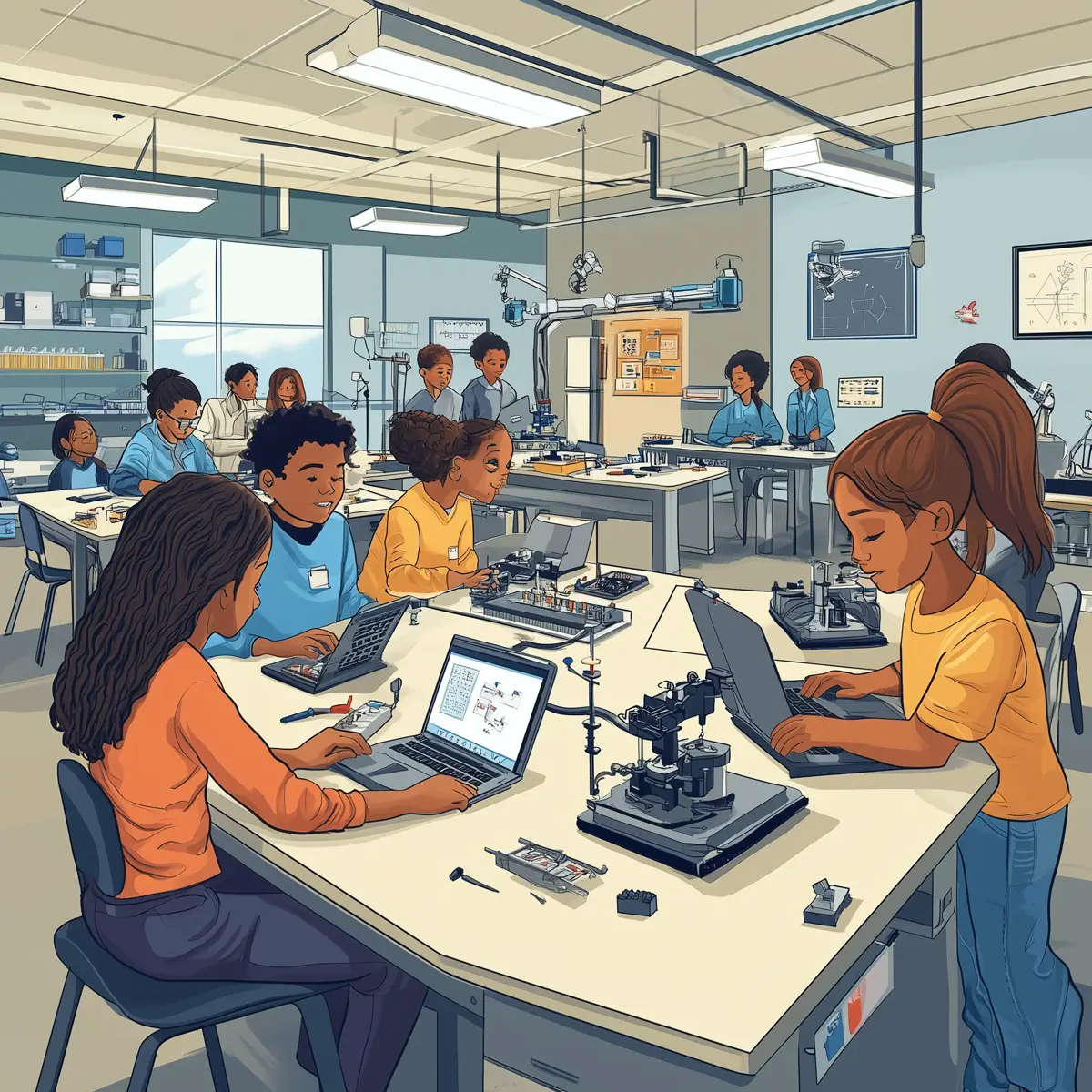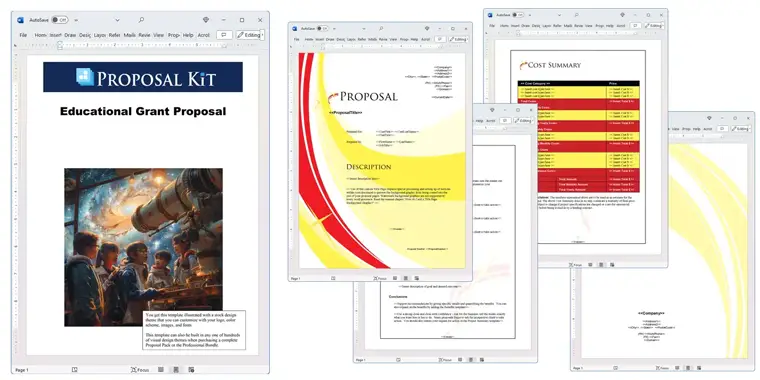How to write your Educational Grant Proposal
We include this 19 page layout with every Proposal Pack. If you want this template to have a different visual design theme than the one illustrated here, purchase any Proposal Pack design and create this template using the purchased design theme. This template is included in every Proposal Pack. If you get a Proposal Pack or the Professional, you can also make any variation of this template with different chapters to suit your needs.
We typically include more chapters in the templates than most people will need to give everyone more variety in the chapters they may need. You can trim down a long template by removing pages you do not need or combining multiple chapter topics into one page.
 DOWNLOADABLE, ONE-TIME COST, NO SUBSCRIPTION FEES
DOWNLOADABLE, ONE-TIME COST, NO SUBSCRIPTION FEES![]() View Educational Grant Sample Proposal
View Educational Grant Sample Proposal
This sample proposal is based on the same layout as this template and is included in every Proposal Pack. The visual design of the templates will match whichever Proposal Pack design you purchase. To get this template in a different design theme than shown in the sample, purchase any other Proposal Pack design theme and this template will be included.
You can create an editable Word version of this sample in any design theme of your choice including branded to your logo.
You can also create countless variations of this document to suit your needs using the included library of 2200+ chapters if ordering a Proposal Pack or Professional.
 What Our Clients Say
What Our Clients SayTemplates are very well researched and created. The vast repository of templates and formats are great for the experienced. We have used a small set of templates and have found them to be extremely good as a framework to develop the proposal around. One of the best researched products I have seen in the market. Excellent Templates."
Related Article
Related Video
Related Templates
- Educational Grant Proposal #2
- Daycare Preschool Grant Funding Proposal
- DOE Federal Government Grant Proposal
- STEM Educational Program Proposal
- Vocational Education Proposal
- New College Curriculum Proposal
- Charter School Educational Proposal
- Specialized Training Educational Proposal
- Tutoring Educational Services Proposal
- Educational Grant Proposal
- School Improvement Project Proposal
- Computer Lab for Students Educational Proposal
- DOE Federal Government Grant Proposal #2
- Educational Training for Special Needs Proposal
- Science Lab for Students Educational Proposal
- Mobile Literacy Program Funding Proposal
- School Funding Request Proposal
- DOE Federal Government Grant Proposal 2
- Music School Educational Proposal
- Ranching Educational Grant Funding Proposal
- Art Therapy Grant Proposal
- Educational Grant Proposal 2
- Grant Funding Request Proposal
- Grant Proposal for Special Needs Support
- Online School and Media Outlet Funding Proposal
What's the best way to write your educational grant proposal?
The solution is straightforward: using the Proposal Kit template and software package. Tailored to streamline the complex proposal writing process, Proposal Kit provides a structured approach with professionally designed templates and a comprehensive software tool, the Proposal Kit Wizard.
This system helps create persuasive text and manages financial details through its integrated line item quoting database system for costs, quotes, estimates, budgets, and other financial statements.
Are you currently facing the challenge of writing an educational grant proposal?
What Types of Projects Are Educational Grant Proposals Written For?
Educational grant proposals are crucial for schools and educational organizations seeking funding to enhance or establish student programs.
The template illustrated here is for an educational program seeking funding, such as from another organization or government agency. Academic institutions also use the Proposal Kit to write their grant RFPs and for others to write their responses to such RFPs. The Proposal Kit covers all these angles, and template layouts for those other situations are also included.
These grant proposals for education must clearly articulate the purpose, methodology, expected outcomes, and budgetary needs. Projects typically funded through educational grants include:
- Technology Upgrades: Implementing new technology in classrooms, such as tablets or smartboards.
- Curriculum Development: Creating and testing new curricula to improve or diversify learning outcomes.
- After-School Programs: Establishing extracurricular activities that support academic skills or social development.
- Professional Development: Training teachers to enhance their teaching skills or introduce new teaching methods.
- Infrastructure Improvement: Upgrading facilities like libraries or science labs.
- Student Scholarships: Providing funding for talented or underprivileged students.
- Community Partnership Programs: Developing programs in collaboration with local businesses or non-profits.
- Art and Music Initiatives: Supporting or expanding school art and music education.
- Environmental Projects: Initiatives like green classrooms or outdoor learning spaces.
- Health and Wellness Programs: Promoting student health through active living, nutrition education, or mental health resources.
Chapters this template is built with
When assembled using the Proposal Kit's templates, these topics will help construct a thorough and professional educational grant proposal.
These chapters are just a few of the thousands available in Proposal Kit's extensive template library, allowing you to customize your proposal to cover every needed topic.
Cover Sheet
The cover sheet serves as the entry point to your proposal. It should be organized and aesthetically pleasing, showcasing the project title, the submitting organization's name, and the submission date. This page sets the tone for the proposal, underscoring its professionalism and seriousness. It must succinctly encapsulate the project's essence, enabling funders to grasp the proposal's objective at a glance.
Executive Summary
The executive summary is a snapshot of your grant proposal, designed to engage the reader immediately. This section should briefly highlight the project's objectives, the problem it addresses, and the impact of potential funding. It should clarify why funding is essential, summarize the expected outcomes and benefits, and make it compelling and impossible for funders to overlook.
Needs Assessment
In the needs assessment, detail the specific needs your project addresses to provide a solid foundation for the proposal. Use relevant data and evidence to depict the problem and its significance. This section should resonate with the reader, making a solid case for why your project is necessary and how it aligns with the funder's objectives.
Project Methods
The project methods section delves into the 'how' of your proposal. Detail the strategies and steps your project will take to achieve its goals. Include information on methodologies, project phases, and critical activities. Articulating this section reassures funders that the project is well-planned and feasible.
Project Background
The project background should provide context by discussing any preceding efforts related to the current proposal. Highlight previous successes or lessons learned and how they shape the new proposal. This section establishes credibility and demonstrates a thoughtful approach to building on past experiences.
Timeline
A well-defined timeline is crucial for demonstrating the project's organization and feasibility. Detail the project phases with start and end dates, including key milestones. This helps funders understand the project's duration and critical checkpoints.
Curriculum
If the grant supports educational content development, detail the curriculum aspects here. Describe what will be taught, how it will be delivered, and the academic goals it aims to achieve. This section should align closely with the overall objectives of the grant, showing how the educational content fills a gap or meets a specific need.
Resources
List and describe all necessary resources for the project, including materials, technology, and human resources. Specify any significant equipment or facilities that the project requires. Demonstrating that you have a clear plan for resource allocation is crucial for building trust with funders.
Evaluation
Detail how the project's success will be measured. Discuss the evaluation methods, tools, and criteria you will use to assess the educational outcomes and the project's impact. This section should convince funders that the project's effectiveness will be diligently monitored and evaluated.
Sources of Funds
Identify and describe other funding sources and contributions. This demonstrates broad support for the project and its financial sustainability and reassures funders that their investment is part of a larger, cooperative funding effort.
Uses of Funds
Provide a detailed account of how the grant money will be allocated. Break down the costs associated with each aspect of the project, showing alignment between budget items and project activities. Clarity in this section ensures funders that their money will be used efficiently and purposefully.
Funding Request
Clearly state the total amount of financial assistance needed. This section should include a direct appeal to the funders, explaining why their support is critical to the project's success. Make it clear, concise, and compelling.
Budget
Offer a detailed financial plan, itemizing and justifying each expense. This should include direct and indirect costs, providing a transparent overview of managing funds. Thorough justifications should build confidence in your financial governance.
About Us
Share your organization's background, including its history, mission, and prior successes. Highlight qualifications and past experiences that position you to execute the project successfully. This builds credibility and rapport with funders.
Education
Describe the educational philosophy and strategies that underpin the project. Discuss how these approaches are supported by current research or evidence. This section should align with the overall educational objectives of the grant, reinforcing the project's foundation.
Faculty
Detail the qualifications and roles of key project personnel. Highlight their expertise, past achievements, and specific responsibilities in the project. Demonstrating strong leadership and specialized knowledge reassures funders of the project's potential for success.
Use cases for this template
Max's Mastery
Max, a small business owner in the educational tech sector, was poised to revolutionize learning through an innovative app to enhance interactive learning in schools. To bring his vision to life, Max required substantial funding, which hinged on the strength of his educational grant proposal.
Max structured his proposal using the Proposal Kit, emphasizing the app's unique ability to engage students and improve academic outcomes. The explicit, persuasive content outlined how the app integrates with existing school curriculums and provides measurable educational benefits.
The professionalism conveyed through the Proposal Kit's templates not only streamlined the proposal's development but also significantly boosted its appeal to grant committees. This well-written document resonated with the funders, leading to the grant's approval, thus setting the stage for the app's successful rollout in schools.
Julia's Just-in-Time Proposal
A project manager at Dynamic Development Co., Julia was racing against time. She was tasked with securing funding for a newly conceptualized educational program, so she faced a deadline to submit a detailed grant proposal.
Amid the crunch, Julia turned to an AI writing tool to help expedite the drafting process. However, the Proposal Kit truly transformed her efforts into a polished and persuasive proposal. The Proposal Kit's structured templates provided a solid framework, ensuring each proposal section was comprehensive and aligned with the funder's interests.
Julia's adept use of the Proposal Kit's tools and prompts resulted in a narrative highlighting the program's potential impact and innovation. Her timely submission met the critical deadline and impressed her superiors, ultimately securing the needed funding and earning accolades for her meticulous and efficient handling of the proposal process.
Sam's Strategic Submission
Sam, the director of Community Edu-Nonprofit, recognized the potential of a community-based educational initiative to foster significant local impact. The project required a diverse range of contractors, and an explicit, structured Request for Proposal (RFP) was crucial to attracting the right partners.
Sam chose the Proposal Kit to create this document, valuing the templates' comprehensive nature, which facilitated a detailed articulation of the project scope and requirements. Each section of the RFP was carefully addressed, from project objectives to logistical needs, ensuring that potential contractors thoroughly understood the project's demands and goals.
The clarity and depth provided by the Proposal Kit helped Sam communicate with a broad audience of potential bidders. The process resulted in a robust selection of proposals, enabling the non-profit to choose partners that aligned closely with their vision and budget, ensuring the initiative's success.
Conclusions and Recommendations
The Proposal Kit is invaluable for anyone writing an educational grant proposal. By providing expertly designed templates and a robust software system, Proposal Kit not only simplifies the writing process but also enhances the quality of your proposals, ensuring you present your best case to funders.
Also Known As
This template may also be referred to in different ways or be used in more specialized situations, such as:
- Academic Funding Request
- Scholarship Application Proposal
- Learning Initiative Submission
- Educational Project Funding Application
- Program Support Proposal
- Institutional Grant Application
- Academic Research Funding Request
- School Improvement Funding Proposal
- Teacher Grant Application
- Educational Development Proposal
Abstract
 Writing a successful educational grant proposal lies in a meticulous grant writing process that ensures all details align with the funding agency's objectives. For schools and educational institutions seeking grant funds, a structured proposal is vital to secure grant funding for various initiatives, such as technology upgrades or after-school programs. A winning grant proposal begins with a cover letter and follows a specific structure that includes a proposal summary, project description, and budget justification.
Writing a successful educational grant proposal lies in a meticulous grant writing process that ensures all details align with the funding agency's objectives. For schools and educational institutions seeking grant funds, a structured proposal is vital to secure grant funding for various initiatives, such as technology upgrades or after-school programs. A winning grant proposal begins with a cover letter and follows a specific structure that includes a proposal summary, project description, and budget justification.
By focusing on measurable outcomes and the organization's mission, applicants can demonstrate the project's value and potential impact. Understanding the grant agreement and adhering to specific requirements are crucial steps in the application process as they prepare the groundwork for a successful grant application.
The Proposal Kit provides a professional writing tool that simplifies the task of writing proposals. This software aids in creating a proposal that meets the funding agency's standards, offering templates for each topic of the proposal. For example, applicants can use the Proposal Kit to outline a clear project timeline or analyze potential sources of additional funding and other resources. The grant letter must convincingly communicate the project's intended outcomes and the necessity of federal funding or support from other grant-making entities.
 Through the learning process of writing a grant proposal, applicants gain insights into the importance of gathering all the materials needed, organizing the project background, and consulting with grant reviewers to double-check the proposal's validity. The Proposal Kit's comprehensive system even assists first-time writers in becoming aware of the specific requirements needed to avoid rejection. By practicing grant writing techniques and seeking feedback, educators and administrators can refine their proposals, making them more competitive.
Through the learning process of writing a grant proposal, applicants gain insights into the importance of gathering all the materials needed, organizing the project background, and consulting with grant reviewers to double-check the proposal's validity. The Proposal Kit's comprehensive system even assists first-time writers in becoming aware of the specific requirements needed to avoid rejection. By practicing grant writing techniques and seeking feedback, educators and administrators can refine their proposals, making them more competitive.
Moreover, by identifying eligible grant opportunities and undertaking a search, potential funders can be matched with projects that align with their interests. A step-by-step guide within the Proposal Kit ensures that applicants adhere to rules and provide a complete narrative that encompasses all the necessary components, such as a problem statement and an evaluation plan. This comprehensive approach helps demonstrate the project's feasibility and the applicant's capability to manage the grant period.
Writing a successful educational grant proposal involves a combination of planning, professional writing, and an understanding of the funding landscape. By using tools like the Proposal Kit, applicants can articulate a clear vision that resonates with grant-making bodies, ultimately securing the necessary funding to support vital educational initiatives.
 Applicants must focus on creating a proposal that aligns seamlessly with the funding agency's expectations. The Proposal Kit stands out as a resource, offering a structured approach to writing proposals, complete with professionally designed templates that cater to both experienced grant writers and those attempting this for the first time. By using this tool, applicants can present their proposed project in a manner that emphasizes its significance and feasibility.
Applicants must focus on creating a proposal that aligns seamlessly with the funding agency's expectations. The Proposal Kit stands out as a resource, offering a structured approach to writing proposals, complete with professionally designed templates that cater to both experienced grant writers and those attempting this for the first time. By using this tool, applicants can present their proposed project in a manner that emphasizes its significance and feasibility.
The Proposal Kit helps applicants create a comprehensive project description that not only outlines the project's objectives but also addresses the specific needs it aims to solve. This is achieved by employing a detailed problem statement supported by evidence from other sources, thereby adding depth to the proposal. The inclusion of measurable outcomes and a realistic budget narrative further strengthens the proposal, providing a clear pathway to achieving the desired outcomes.
In developing a successful grant proposal, it is imperative to outline the organization's specific mission and demonstrate how the proposed project aligns with it. This connection is crucial in proving the project's relevance to potential funders. Moreover, the inclusion of a detailed budget justification and a clear use of grant funds ensures transparency and builds trust with grant-making entities.
 Successful applicants understand the importance of adhering to the specific structure required by grant reviewers. By organizing all the materials, including a timeline and a detailed evaluation plan, applicants can present a proposal that not only meets but exceeds the expectations of funding agencies. This attention to detail is vital to avoid last-minute rejections and to prove the project's viability within the grant period.
Successful applicants understand the importance of adhering to the specific structure required by grant reviewers. By organizing all the materials, including a timeline and a detailed evaluation plan, applicants can present a proposal that not only meets but exceeds the expectations of funding agencies. This attention to detail is vital to avoid last-minute rejections and to prove the project's viability within the grant period.
Furthermore, applicants are encouraged to consult with research assistants or educators to gather feedback and refine their proposals. This collaborative effort can enhance the quality of the proposal, ensuring it addresses all the details necessary for success. Engaging with other resources, such as courses on grant writing, can also provide valuable tips and insights, helping applicants avoid common pitfalls and increasing their chances of receiving funding.
In summary, a well-written educational grant proposal is the result of careful planning, the use of resources like the Proposal Kit, and a deep understanding of the application process. By focusing on the importance of clarity, alignment with the funding agency's goals, and a robust demonstration of the project's potential impact, applicants can create a narrative that resonates with funders, leading to the proposal being awarded the necessary support to drive educational advancements.
Frequently Asked Questions
What should be included in an educational grant proposal?
An educational grant proposal typically includes several key components: an executive summary, a statement of need, project goals and objectives, a detailed project plan, a budget, and an evaluation plan. The executive summary provides a concise overview of the proposal. The statement of need explains why the project is necessary. The project goals and objectives outline what the project aims to achieve. The detailed project plan describes the methods and activities that will be used to accomplish these goals. The budget provides a financial breakdown of the project's costs. Finally, the evaluation plan discusses how the project's success will be measured.
How do I identify the right funding source for my educational grant proposal?
Identifying the right funding source involves researching organizations that align with your project's goals and objectives. Look for foundations, government agencies, and private donors with a history of supporting similar initiatives. Review their funding priorities, eligibility criteria, and application guidelines. Networking with colleagues and attending grant-writing workshops can also provide valuable insights. Ultimately, the best funding source will be one that shares your vision and is interested in the specific impact your project aims to achieve.
What is the best way to demonstrate the need for my project in the proposal?
To demonstrate the need for your project, provide precise, evidence-based data highlighting the problem you aim to address. Use statistics, research studies, and expert testimonials to substantiate your claims. Additionally, it includes anecdotal evidence and case studies that bring a human element to the data. Clearly articulate how your project will address the identified need and why it is the best approach. This establishes the urgency and builds a case for why funders should support your initiative.
How detailed should my budget be in the grant proposal?
Your budget should be as detailed and transparent as possible. Break down expenses into specific categories such as personnel, materials, equipment, travel, and other relevant costs. Include justifications for each expense to show how it directly supports the project's goals. If applicable, outline any matching funds or in-kind contributions. A well-prepared budget helps funders understand your project's financial requirements and demonstrates your ability to manage funds responsibly.
What strategies can I use to make my proposal stand out?
To make your proposal stand out, focus on clarity, conciseness, and impact. Write clearly, professionally, and persuasively, avoiding jargon and overly complex language. Tailor your proposal to the specific interests and guidelines of the funding source. Highlight innovative aspects of your project and its potential for significant impact. Use visuals such as charts and graphs to illustrate key points. Including letters of support from credible partners or stakeholders can also strengthen your proposal by demonstrating community or institutional backing.
20% Off Discount
![]() Add To Cart This Word Template
Add To Cart This Word Template
 Add To Cart Proposal Pack In Motion #4
Add To Cart Proposal Pack In Motion #4
 Add To Cart Proposal Kit Professional
Add To Cart Proposal Kit Professional
 4.7 stars, based on 849 reviews
4.7 stars, based on 849 reviewsProposal Kit chapters used in this template
Cover Sheet, Title Page, Table of Contents, Executive Summary, Needs Assessment, Education, Curriculum, Faculty, Resources, Project Methods, Project Background, Time Line, Evaluation, Sources of Funds, Uses of Funds, Funding Request, Budget, About Us, Back Page
Line Item Automated Chapters
If you purchase a Proposal Pack or the Professional Bundle, these proposal pages are generated using an automated line-item database in the included Wizard software.
Time Line, Funding Request, Budget Three Year
You use this proposal for
- General business proposal
- Education, training proposal
- Non-technical proposal
- Project pitch proposal
- Non-government grant, non-profit, NGO proposal
- Student project proposal
How to create this template with Proposal Pack Wizard
You can create this document using any of the logo-designed Proposal Packs. Pick any Proposal Pack with a logo design theme you like best; they will all work equally well. The Proposal Pack for Any Business is the pack with no extra added logos or colors - designed to be used plain or for you to customize with your logos and graphics.
The Proposal Pack design theme you purchase will determine the visual look of this template. The screenshot above only shows the plain generic design theme.
We include a library of chapters to be assembled based on your needs. All proposals are different and have different needs and goals. We designed Proposal Pack so you can customize the documents to suit your needs.
You will best create this document using the Proposal Pack Wizard - Expert Edition software to select this template and build it in the Proposal Pack logo design theme of your choice along with any desired customizations (such as adding additional chapters, removing unneeded chapters, changing the order of chapters, and importing your company logo). This template outlines a proposal for the described situation. Each user is responsible for typing in the actual content of the provided pages with their information to complete the proposal. Suggestions in the abstract may include features in higher-end packages and are facilitated by the selection of chapter templates to support the narrative of each proposal, which help guide the user in filling in the details.
The Wizard software's AI Writer will write the content of the pages of the template based on details provided for your company, client, project, financial details and other writing instructions. This will provide a personalized version of the template completely written and ready to edit.
Once finished, the AI Writer's Word-to-PowerPoint converter can transform your proposal, business plan, or other business documents into a PowerPoint slideshow. Save time and effort by letting the AI analyze every chapter to condense its content into talking points, visually matching the document, and providing a consistent package of presentation material with the click of a button.
You create this template using the Wizard software with an entire Proposal Pack library and software. We include the Expert Edition of the software in the Proposal Kit Professional. Microsoft Word for Windows is required to use the customizing software. You can also edit Word document templates in other office software such as Word for Mac. We will assist Mac users in assembling complex templates for their first project if they do not have the required platform to run the Wizard software.
How to Build Templates Featured on Proposal Kit Website
Many people find the Proposal Kit website after searching for a specific proposal. Once you've purchased and installed the software, how do you build that template you found in the first place? This video shows you how to build any proposal you see on the Proposal Kit website.
 Ian Lauder has been helping businesses write their proposals and contracts for two decades. Ian is the owner and founder of Proposal Kit, one of the original sources of business proposal and contract software products started in 1997.
Ian Lauder has been helping businesses write their proposals and contracts for two decades. Ian is the owner and founder of Proposal Kit, one of the original sources of business proposal and contract software products started in 1997.By Ian Lauder
 Published by Proposal Kit, Inc.
Published by Proposal Kit, Inc.


 Cart
Cart
 Get 20% off ordering today:
Get 20% off ordering today: 


 Facebook
Facebook YouTube
YouTube Bluesky
Bluesky Search Site
Search Site